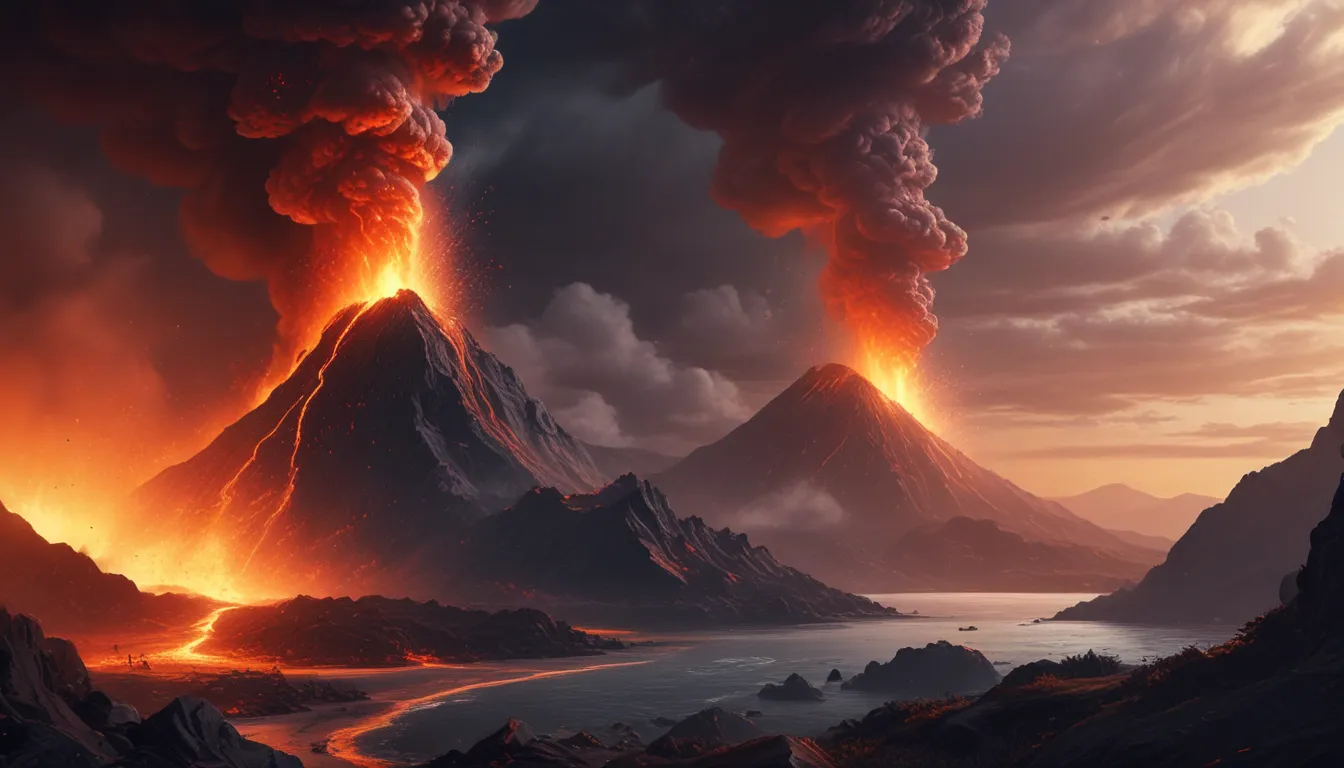A Note About Images: The images used in our articles are for illustration purposes only and may not exactly match the content. They are meant to engage readers, but the text should be relied upon for accurate information.
Introduction:
Active volcanoes have been capturing the imagination of humans for centuries with their awe-inspiring displays of power and beauty. These natural wonders not only shape the Earth’s landscape but also play a significant role in influencing our climate. In this article, we will delve into 13 astonishing facts about active volcanoes, shedding light on their power, significance, and impact on our planet. Prepare yourself for an exciting journey into the fiery depths of the Earth as we uncover the mysteries of these geological marvels.
Unveiling the Power of Active Volcanoes
- Active volcanoes are powerful and unpredictable, with approximately 1,500 of them scattered worldwide. They not only shape the Earth’s geography but also create new landmasses while posing risks to aviation and triggering tsunamis. Despite their dangers, these fiery mountains showcase the Earth’s beauty and energy, captivating our imagination with their mesmerizing displays.
The Dynamic Nature of Active Volcanoes
Active volcanoes are in a constant state of eruption, spewing lava, ash, and gases from the Earth’s mantle. These eruptions can vary from small explosions to massive cataclysmic events, making active volcanoes a source of continuous awe and fascination. Their frequent activity serves as a reminder of the Earth’s dynamic and ever-changing nature.
Exploring the Global Presence of Active Volcanoes
Around the world, there are roughly 1,500 active volcanoes dispersed across various continents and even underwater. These volcanic hotspots bear witness to the dynamic forces that shape our planet and contribute to its geological diversity. The diversity and distribution of active volcanoes highlight the remarkable nature of our Earth’s composition.
The Pacific Ring of Fire: A Hotbed of Volcanic Activity
The Pacific Ring of Fire, also known as the Circum-Pacific Belt, harbors about 75% of the world’s active volcanoes. This region, spanning the Pacific Ocean, is highly prone to earthquakes and volcanic eruptions due to the continuous movement of tectonic plates. It serves as a hub of volcanic activity, showcasing the Earth’s volatile and dynamic nature.
The Fiery Temperatures of Volcanic Eruptions
Volcanic eruptions can reach extreme temperatures, with molten lava surpassing 1,000 degrees Celsius during an eruption. This intense heat can cause widespread devastation, melting everything in its path and reshaping the surrounding landscape. The scorching temperatures of volcanic eruptions underscore the immense power and destructive potential of these natural phenomena.
The Genesis of New Land: A Volcanic Creation
Volcanic eruptions play a pivotal role in forming new land formations, such as islands or expanding existing landmasses. Layers of solidified lava and volcanic debris accumulate over time, shaping new land areas and contributing to the Earth’s ever-evolving geography. The creation of new land through volcanic activity exemplifies the transformative impact of these fiery mountains.
Unlocking the Marvel of Olympus Mons on Mars
Olympus Mons, situated on the planet Mars, stands as the largest known volcano in the entire solar system. Its colossal size and distinctive geological features make it a subject of fascination for scientists studying the red planet. The magnitude of Olympus Mons showcases the magnificence and diversity of volcanic structures across our solar system.
The Far-Traveling Ash of Volcanic Eruptions
During a volcanic eruption, copious amounts of ash are released into the atmosphere, capable of traveling vast distances propelled by wind currents. Volcanic ash can journey thousands of miles away from its source, influencing the environment and human health. The dispersion of volcanic ash highlights the far-reaching effects of volcanic activity on a global scale.
Submarine Volcanoes: Unseen Forces Beneath the Waves
Some active volcanoes remain hidden underwater, submerged beneath the ocean’s surface as submarine volcanoes. Despite their concealed nature, these underwater volcanic vents have significant impacts, including the creation of seamounts and the release of volcanic gases into the water. The presence of submarine volcanoes underscores the widespread distribution and influence of volcanic activity in our seas.
Unleashing Tsunami Potential: The Impact of Underwater Eruptions
Underwater volcanic eruptions possess the potential to trigger tsunamis, generating massive waves that can travel across oceans and devastate coastal regions. The violent displacement of water caused by underwater eruptions highlights the profound impact of volcanic activity on marine environments. The correlation between submarine volcanoes and tsunamis underscores the dynamic and interconnected nature of geological processes.
Climate Influence: The Gases Emitted by Volcanic Eruptions
Volcanic eruptions release significant quantities of gases, including sulfur dioxide and carbon dioxide, into the atmosphere. These gases can have a notable impact on the Earth’s climate, affecting temperature patterns and atmospheric composition. The role of volcanic gases in shaping our climate underscores the intricate relationship between natural phenomena and environmental dynamics.
Vigilance and Preparedness: Monitoring Active Volcanoes
Given their unpredictable nature, active volcanoes are meticulously monitored by scientists and geologists using various techniques such as seismic activity measurements and gas emissions analysis. Continuous monitoring enables early detection of volcanic activity, providing essential warnings to at-risk communities. The vigilance and preparedness measures surrounding active volcanoes emphasize the importance of scientific monitoring for hazard mitigation.
Aviation Hazards: The Dangers of Volcanic Ash
Volcanic ash poses a significant risk to aviation, as the tiny particles can damage aircraft engines and lead to engine failure. Air travel in proximity to active volcanoes is often disrupted during eruptions to prevent potential hazards to aircraft and passengers. The hazards posed by volcanic ash underscore the complex challenges faced in ensuring aviation safety amidst volcanic activity.
Awe-Inspiring Natural Spectacles: The Beauty of Volcanic Eruptions
Despite their destructive potential, volcanic eruptions create spectacular natural phenomena that captivate our senses and ignite our fascination. From cascading lava flows and electrifying volcanic lightning to formidable volcanic bombs and mesmerizing pyroclastic flows, these displays of nature’s power remind us of the Earth’s remarkable beauty and energy. The juxtaposition of destruction and beauty in volcanic eruptions highlights the multifaceted nature of these geological events.
Conclusion:
In conclusion, active volcanoes stand as captivating geological wonders that hold vast potential for discovery and exploration. From their profound power to their diverse impacts on the Earth, these fiery mountains continue to intrigue scientists and enthusiasts worldwide. By delving into the complexities of active volcanoes, we gain valuable insights into our planet’s geological processes and the interconnectedness of natural phenomena. Through ongoing research and technological advancements, we can deepen our understanding of active volcanoes and mitigate potential hazards for our communities. Embrace the wonder and beauty of active volcanoes as you embark on a journey of discovery into the heart of our ever-evolving planet.






